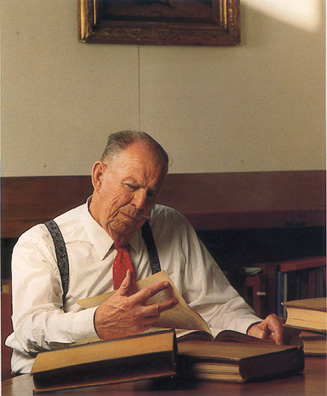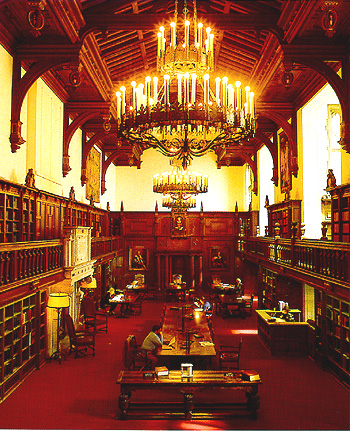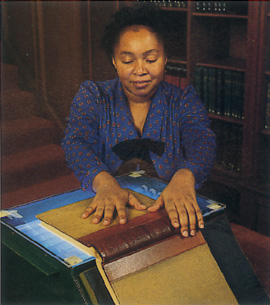
With an insatiable appetite for research, Tom Gravell has become a world-renowned expert on watermarks, co-authoring two books on the subject.
|
|
With an insatiable appetite for research, Tom Gravell has become a world-renowned expert on watermarks, co-authoring two books on the subject. |
If you get the impression that Gravell is a history buff, you're only partially right. While his conversations are liable to touch authoritatively on economics, politics, religion, manufacturing, and several other subjects, his consuming passion, and the wellspring from which he derives most of this knowledge, is watermarks--the faint designs on paper that are discernible only by placing the paper in front of a light source.
A former DuPont employee (retiring in 1975 after 34 years of service), the grandfather of five has become one of the world's most respected authorities on this rather esoteric subject.
He corresponds with academicians from around the globe, who sometimes visit his backyard workshop in Wilmington, Delaware. He's authored two books on watermarks with George Miller, director of undergraduate English studies at the University of Delaware. And perhaps most important, he has developed an inexpensive means of reproducing watermarks, using DuPont's "Dylux" 503 instant proof paper.
Watermarks originated with 13th century Italian papermakers, who used them to [p. 5] identify their particular product. They formed devices such as crosses, circles, triangles, and simple figures by twisting wire into the desired shape. They sewed the design to the mold on which the paper was to be made, and the wire caused the paper's fiber to be thinner in the area of the design, leaving an impression on the wet sheet of paper. This was the accepted water-marking method until the mid-19th century, when more sophisticated procedures were developed. (Curiously, the Chinese, who invented paper in 105 A.D., never used watermarks.)
The Folger Shakespeare Library in Washington, D.C. is
an invaluable resource for Gravell and other researchers.
The Folger is equipped with an exposure unit for reproducing
"Dylux" copies.
"Reproduced accurately," says Gravell, "a watermark can give a
possible date of composition and place of origin for the document on
which it appears. This information often can prove or disprove the
authenticity of prints, books, maps, and manuscripts."

Gravell was drawn into the world of watermarks in 1970 because of his extensive stamp collection. He owned several German "inflation stamps" from the 1930s and he wanted to copy their watermarks. Verifying the watermarks would increase the value of the stamps. The stamps, however, were on letters. "That made them more valuable," says Gravell, "but it also seemed to make it impossible to get a copy of the watermark."
In the midst of this quandary, he learned about "Dylux" 503 photosensitive paper, a proofing product DuPont had just introduced to the printing industry. In its broadest graphic arts application, a film negative of the material to be proofed is laid over "Dylux" paper and exposed to ultraviolet light. This produces a chemical reaction that results in a blue image. The image is then "fixed" by exposing the proofing paper for several seconds to bright visible light, or to room light for approximately an hour.
[p. 6]
|
|
 |
|
At the Folger Library, Gravell and a staff member use the exposure unit he designed. Fluorescent light (above right) and long-wave ultraviolet light (above left) reproduce watermarks, along with a millimeter scale, on "Dylux" paper (right). |
|
After reading about the product in a trade publication, he made some phone calls and got sample sheets. With assistance from Rolf Dessauer and Al MacLachlan, who were instrumental in developing "Dylux", Gravell devised an inexpensive process for detecting and copying watermarks.
Briefly, the process involves placing the watermarked paper and the "Dylux" 503 in close contact and exposing the sheets to visible fluorescent light for one-to-five minutes. Since the watermark creates a "thinness" in the paper, the visible light passes through this thinness with greater intensity and thus nullifies the yellow dye coating on the "Dylux" 503 sheet. Following exposure, the sheets are separated and the exposed "Dylux" is passed under a long-wave ultraviolet light. This irradiation causes the unaffected coating to turn a bright blue, and the watermark emerges as a white image. This simple, effective technique costs only about seven cents per copy.
$20 For Alternative
The other reliably accurate method of copying watermarks is the beta-ray technique, involving a radioactive carbon sheet, which emits radiation that images a silver film. After conventional processing, the film produces an exact copy of the watermark.
This method requires special facilities, such as those at the British Library, and each copy costs about $20. "Also," says Gravell, "beta eliminates the surrounding ink on the copy, so you can't see the handwriting or art that's part of the document. With 'Dylux', you get everything."
Gravell built a simple exposure table in his workshop, and began to immerse himself in the study of watermarks. Both the man and his process soon attracted big names in the art and bibliophile community. Winterthur Museum, located near Wilmington, asked him to work on some of its documents. Scholars asked him to examine letters signed by Thomas Jefferson but obviously not written by him. Through watermarks, Gravell determined that the letters were actually written years after the dates of the letters. (Jefferson, who kept meticulous files, had lost copies of many letters in a fire. He asked recipients of the letters to return the originals to him, and he had scribes copy them, then he affixed his signature). Gravell also designed an exposure unit to make "Dylux" copies for the Folger Shakespeare Library, Washington, D.C.
He's a familiar figure at the Folger, as well as the Smithsonian Library and other libraries and museums throughout the East. His appetite for research is insatiable.
"There's such a great variety of watermarks," he says, "and the information they give you is tremendous. For instance, did you know that there are 18 watermarks on the 1475 edition of Chaucer's Canterbury Tales? Or that Winslow Homer liked to tear the leaves out of books to use for his engravings? Or that . . ."
If you'd like more information on Tom Gravell's proofing process using "Dylux" 503 instant image proof paper, write to "Dylux", DuPont Magazine, Wilmington, DE 19898.